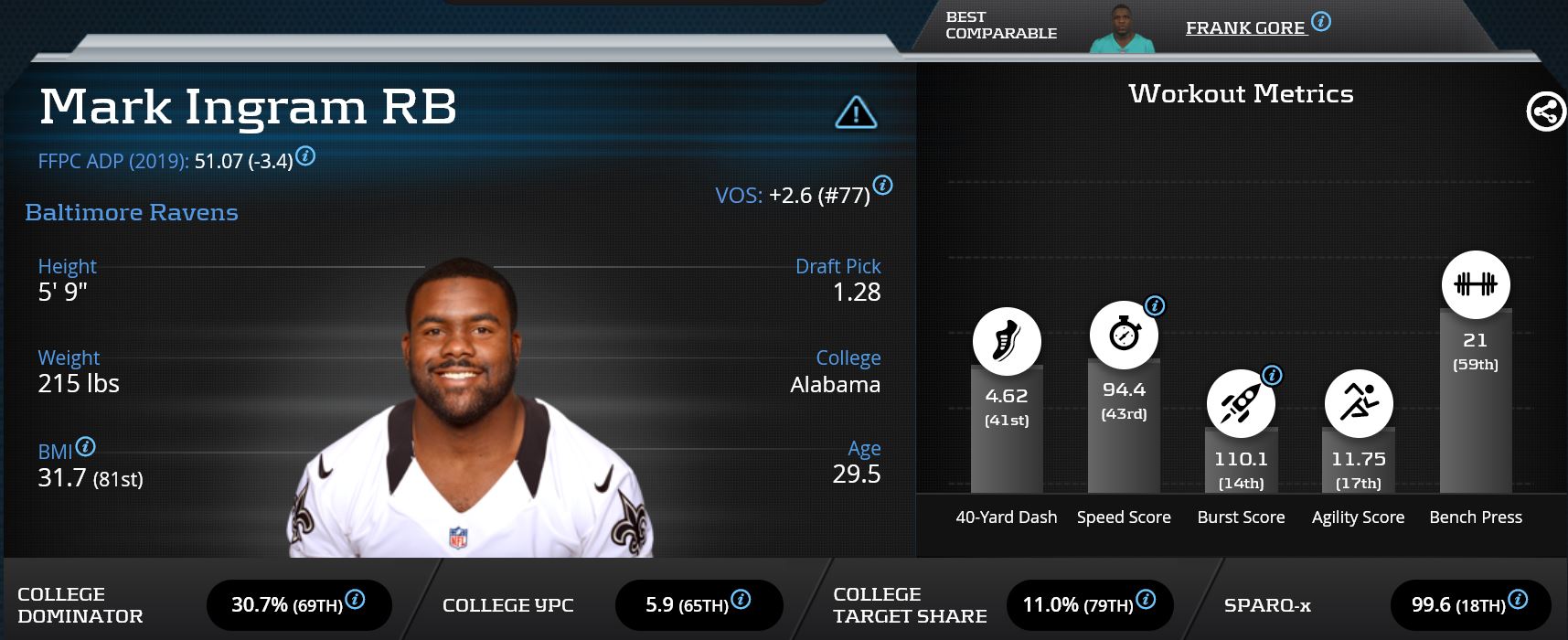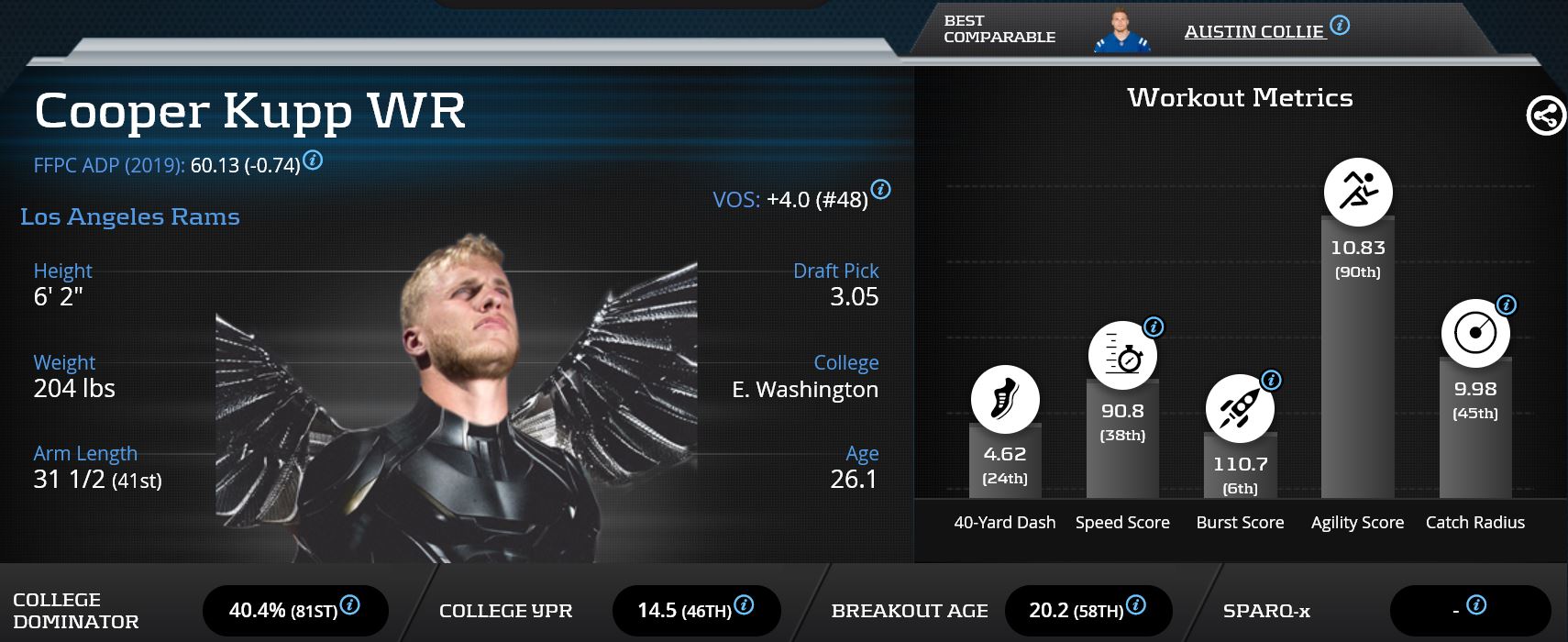There’s no greater feeling in fantasy football than eyeing up that late round sleeper all summer, picking him in your draft and watching him hit. Finding success with a late round dart throw is one part of the winning equation. Avoiding the early-round land mines and middle-round value traps ultimately provides the bigger edge. Sometimes the players that helped fantasy gamers raise their league trophy slide into this trap category by the next season. Identifying these risky players before drafts is an important part of achieving success. These are the nine players whose advanced, stats, metrics and analytics profiles, combined with other key indicators, place them on the 2019 Do Not Draft List.
James Conner, RB, Steelers
It’s not often that you hear a running back publicly say he expects a reduced role in the following season. Given how well he played last year, it’s unexpected that James Conner welcomes sharing the load. Pittsburgh likely recognized that he struggled down the stretch, posting 50.5 rushing yards per game in his final four contests. Jaylen Samuels averaged five targets per game in that same span, including eight in a must win-game where both he and Conner were healthy and active.
https://www.youtube.com/watch?v=CHZ4fdm2-Ys
Whispers out of camp are that Samuels performed well enough last year to earn at least a change of pace role. This wouldn’t be surprising, especially given Conner’s 5.6-percent (No. 14) Drop Rate. His stone hands directly cost the Steelers at least one game last season. He’s a mediocre athlete, evidenced by a 32nd-percentile SPARQ-x score, in an offense expected to take a step back without Antonio Brown. Though he’ll still be startable in 2019, he won’t live up to his first-round ADP.
Nick Chubb, RB, Browns
The narrative with Nick Chubb is that he has top-three upside while Kareem Hunt is out. The Browns offense will likely improve with the addition of Odell Beckham and with Baker Mayfield entering his second season. But it was already excellent in the second half of last season with him seeing the majority of his carries.
Check out Nick Chubb on PlayerProfiler’s “World Famous” Draft Kit:
He also hasn’t been a volume pass catcher since he was a freshman at Georgia, pre-injury. While that limits his upside in PPR leagues, it lowers his rushing ceiling as well. He ranked No. 10 with 7.1 Average Defenders in the Box and a 29.2-percent Stacked Box Carry Rate last season. With the Browns not finding a suitable trading partner for Duke Johnson, it makes sense for them to continue using Chubb in this role. And with Air Raid guru Todd Monken at offensive coordinator except Johnson to see plenty of snaps. It’s also anybody’s guess as to how the workload will be split when Hunt returns. At worst, Chubb’s touches will be scaled back to preserve him for a possible playoff run. And no one should be surprised if Hunt seizes the backfield entirely.
Damien Williams, RB, Chiefs
Nelson Sousa, one of the best high-stakes fantasy drafters in the world, has a simple rule that has worked well for him in the past. Avoid running backs that were available off waivers the year prior and are getting drafted early this season. This has allowed him to avoid landmines like Alex Collins and Kenyan Drake last year and players like Jordan Howard and Jay Ajayi previously.
https://www.youtube.com/watch?v=WrWYw1EyInI
By this criteria, Damien Williams becomes a player to avoid in drafts. The Chiefs offense is expected to take a step back due to natural regression and a potential Tyreek Hill suspension. Meaning that his situation won’t be as fruitful as last year. Carlos Hyde and Darwin Thompson are competing for both the early down and passing game work. So it won’t take much for Williams to underperform his lofty ADP. Counting on a UDFA with a College Dominator Rating, College Target Share, and Breakout Age all below the 50th-Percentile to break out in his age-27 season is foolish.
Phillip Lindsay, RB, Broncos
There’s a reason the fantasy drafting public is excited about Phillip Lindsay. As a 5-7, 184-pound UDFA, he averaged 5.6 (No. 17) Yards Per Touch in his rookie season. He’s a classic feel good story. Unfortunately, it takes more than being a feel good story to be a fantasy football league winner.
https://www.youtube.com/watch?v=w0jnG8M3VSc
Lindsay finished 25th at the running back position with only five goal line carries last season. He also had an 8.5-percent (No. 20) Drop Rate, and finished outside the top-30 in Yards Created, Evaded Tackles, and Juke Rate. While he was more efficient than Royce Freeman, this was at least in part due to offensive line play. Denver recorded a 105.7 (No. 4) Run Blocking Efficiency rating with Lindsay, but a 63.0 (No. 46) mark with Freeman. With Lindsay currently recovering from wrist surgeries, Freeman has a clear path to prove himself early in practice.
Mark Ingram, RB, Ravens
Mark Ingram was in one of the best situations possible in New Orleans. He was in a prolific offense, helmed by a quarterback who peppered his running backs with targets. And it helped him cruise his way to fantasy points. Now he’s in a mediocre offense with a quarterback who sent his lead running back only two targets last season. It’s hard to see where the money touches, goal line carries and targets, will come from. While Ingram is a better pass catcher than Gus Edwards, he’s well past the age apex for running backs. And running quarterbacks generally opt to tuck it and run rather than check it down. Not to mention that he’ll be competing for goal line looks with his own quarterback, limiting scoring opportunities.
For the first time, we’ll be seeing Ingram outside of the most favorable offensive environment possible for running backs. He turns 30 years old in December, and posted an 18th-Percentile SPARQ-x score coming out of Alabama a decade ago. He has a low ceiling, and the floor of a backup RB if Justice Hill overtakes him for lead back duties in-season.
Chris Carson, RB, Seahawks
There are two clear reasons that Chris Carson will disappoint this season. First, the Seattle Seahawks were the most run-heavy team in the league last year. And that tends to bounce back towards the mean in the next year. More importantly, he offers little as a pass-catcher. He saw just 24 targets in 2018, fewer than two per game. But the primary reason Carson is likely to disappoint this season is Rashaad Penny.
Rookie touches among first round RBs since 2014:
Saquon Barkley 352 (2nd among RBs)
Sony Michel 216 (17th)
Rashaad Penny 94 (57th)
…
Leonard Fournette 304 (6th)
Christian McCaffrey 197 (28th)
…
Ezekiel Elliott 354 (2nd)
…
Todd Gurley 250 (10th)
Melvin Gordon (217 (19th)— Ian Hartitz (@Ihartitz) April 22, 2019
Carson was fortunate that Penny was a historic outlier from a volume perspective for a first round running back. The San Diego State product disappointed as he dealt with injuries and conditioning concerns. He has lost weight in the offseason, which can be a significant indicator for running backs. It was one of the earliest signals that Joe Mixon was ready to breakout in 2018. That and the fact that Mixon is #goodatfootball. There’s also approximately one season’s worth of data on Carson in the NFL. There’s a history of underwhelming production from him at Oklahoma State, where he was beat out for lead back duties by Justice Hill. Based on his college production and the team’s investment in him, Penny is poised to takeover the backfield in 2019.
Cooper Kupp, WR, Rams
The best way to win at fantasy football is to fade injury optimism. It worked for those who avoided the likes of Deshaun Watson, Doug Baldwin, and Carson Wentz last year. We’ve seen with Derrius Guice that setbacks can easily happen with an ACL tear. Even if Kupp’s recovery goes perfectly, which his ADP presumes, he likely won’t be fully healthy and productive until midseason.
Fantasy drafters may dismiss this by pointing to Julian Edelman‘s 2018 season. But it’s difficult to compare these situations. Edelman tore his ACL early in the preseason, and had 13 months to recover as he was coming off a four-game suspension. Kupp will be 10 months removed from his ACL tear when the season begins. Remember, Adrian Peterson is the exception, not the rule.
Emmanuel Sanders
Emmanuel Sanders is 32 years old, coming off a December Achilles tear. An injury that Dr. David Chao has said will land him on the PUP list to start the season. Sanders himself has not put a timetable on his return. Recent video of him working out has revived hopes that he can make a full recovery by September. But Dr. Chao has indicated that he is still clearly not 100%.
Check out Emmanuel Sanders on PlayerProfiler’s “World Famous” Draft Kit:
Even once he’s healthy, he’s not walking into a great situation. Joe Flacco hasn’t been “elite” in forever. DaeSean Hamilton demonstrated down the stretch that he deserves targets. And while he cost DFS grinders money down the stretch, Courtland Sutton is still an exciting prospect who can be expected to develop in year two. The Broncos have even added Noah Fant into the mix. The floor with Sanders is that he’s unable to play until 12 months after the injury. By that time, the Broncos could easily be out of the playoff hunt. The ceiling isn’t high enough to warrant that type of risk until the final rounds of drafts.
Honorable Mention: Will Fuller (same logic as Cooper Kupp)
Eric Ebron, TE, Colts
Eric Ebron is the easiest fade in the world right now. Fantasy drafters are starting to catch up, as his ADP has fallen like a stone in recent weeks. This has been for a multitude of logical reasons. He scored 7.7 touchdowns over expectation last year. That masked what was otherwise a largely unimpressive 2018 campaign. He recorded a 56.3% (No. 39) Snap Share, a 6.8 (No. 25) Yards per Target mark and led all tight ends with nine drops.
With Jack Doyle (hip) back in the lineup in Week 8, Eric Ebron saw his snaps cut to 18% vs. OAK. Doyle at 75%.
In three games where Doyle has played this year, Ebron’s snap rates are 45% (Week 1), 26% (W2), 18% (W8). Doyle out-targeting Ebron 22 to 11.
— Graham Barfield (@GrahamBarfield) October 29, 2018
Ebron proponents will point to his Fantasy Points per Game while Jack Doyle was also in the lineup. But those fantasy points were fueled by a sky high touchdown rare in a small sample size. What’s more predictive is the target share that he saw when Doyle played, which paints a less favorable picture. Devin Funchess and Parris Campbell have been added as clear upgrades over Ryan Grant and Chester Rogers. This will make Ebron’s target competition much more fierce in 2019. Fantasy drafters may expect him to replicate his 2018 touchdown rate after years of underperforming in the touchdown column. But that unsustainable touchdown rate makes him this year’s easiest fade at the tight end position.











